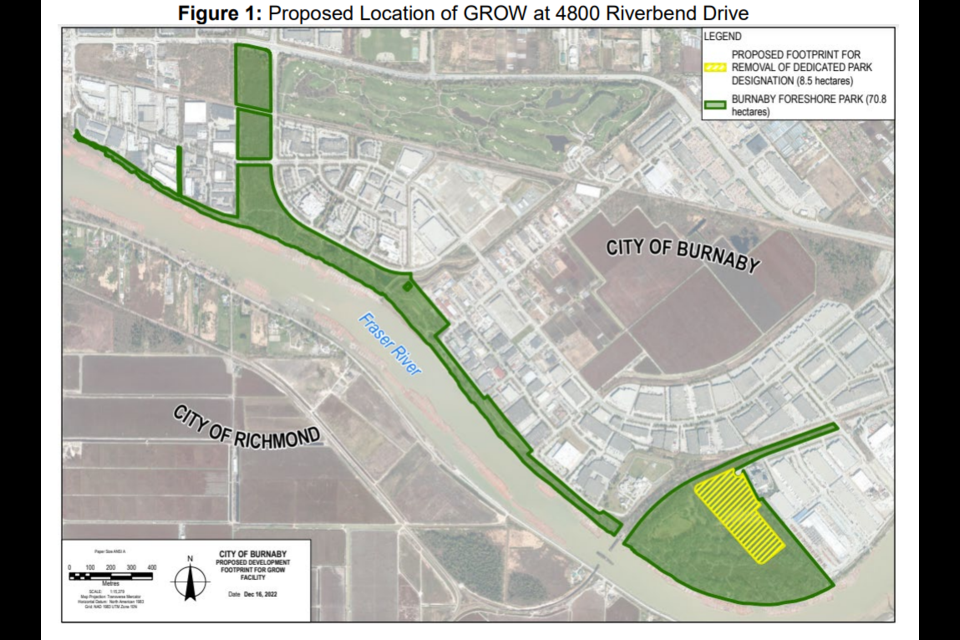Burnaby could be getting a $182-million organic waste processing facility in Fraser Foreshore Park, but it would come with a hefty environmental impact to park land.
City staff are proposing a Green Recycling Organic Waste facility – called GROW – by carving 21 acres out of Fraser Foreshore Park at 4800 Riverbend Dr.
The facility could process up to 150,000 tonnes of green waste such as food scraps and yard trimmings, and create high-quality compost for community gardens and urban farming, as well as renewable natural gas that could be sold for profit, according to a staff report going to council on Feb. 6.
City proposes organic waste facility
The city says the plant would eventually process 50,000 tonnes of waste from Burnaby, and the city could sell the excess capacity to process waste from “neighbouring communities and businesses.”
The GROW facility would replace the current city requirement for processing green waste in a private composting facility in Delta, which staff say is one of “very few” green waste processing facilities in Metro Vancouver.
“This limited processing capacity has led to high tipping fees and repeated price increases,” states the staff report.
The price for processing nearly doubled in 2019, Burnaby’s director of public works, solid waste and recycling, Erik Schmidt, told the NOW. That is when the staff began researching creating its own green waste facility.
The city currently pays about $3.67 million per year for organic waste processing.
Heat generated from composting and other processes at the GROW facility could be used at the nearby Metro Vancouver Waste-To-Energy Facility and a proposed District Energy Utility nearby.
The site would also incorporate a learning centre for students and community groups to see green waste “being converted into renewable energy and compost.”
Will it smell?
The state-of-the-art facility would be enclosed with an air treatment system and “best in class odour control,” according to Schmidt and Sean Mezei, an engineer and consultant on the project at Dekany Consulting.
Noise will be similarly reduced due to the enclosed building, according to Schmidt and Mezei.
The estimated capital cost of the project is $182 million including a 25 per cent contingency.
The Fraser Foreshore Park location is “the only site option to meet the required criteria,” according to the report.
Staff say the location isn’t currently used for recreational purposes and noted the location options for the plant were “limited” since the requirements included a large site size and “distance from residential areas to minimize operational impacts, such as noise, odour and traffic.”
What about the environmental impact?
The development of GROW will affect almost 20 acres of wetland habitat (including more than 10 acres of swamp, about six acres of forest and almost three acres of marsh).
The city will need to get federal and provincial approvals before construction and will consult with a variety of government agencies and First Nation governments.
Staff plan to offset the environment impact with a preservation strategy that they say would be “the largest program package of environmental enhancement the city has ever undertaken,” preserving triple the amount of habitat as would be lost by building the facility.
The city says it would create “high-value habitat” for fish, particularly salmon, in the Fraser River, as well as restore wetland environments around the city.
The city says it has also tried to minimize the facility’s impact by “pushing it as far back from the Fraser River as possible,” and reducing the building’s footprint.
Would this organic waste plant make money for Burnaby?
Originally planned as a 50,000-tonne operating capacity, staff recommended the GROW facility have a 150,000-tonne per year operating capacity that can produce biogas, which would earn revenue for the city.
Staff said the larger facility would be “most economically feasible” as it could sell excess capacity and work with Fortis BC in a renewable natural gas (RNG) off-take agreement.
The city hasn’t released an official annual revenue total, but the facility could generate a potential revenue of $18.21 per tonne from the excess capacity, meaning it could be roughly in the $1.8 million per year range.
Park status poses problem
The proposed GROW facility would be located on a site that is currently dedicated as park land; 12 per cent of the park would be lost if the facility were built.
To develop the site, the city must petition the public through an official process similar to a vote, where the municipality measures whether the community considers the matter as “significant.”
City staff noted that 25 per cent of Burnaby is park and open space, about 2,465 hectares “or six times the size of Stanley Park,” and that the city dedicated more than 200 acres as park land after voter approval in last October’s election.
More information on the process (officially called an “alternate approval process”) will be presented this spring.
Next steps for the city include public engagement beginning this month, if approved by council on Feb. 6. Staff will also consult potential project partners for further information on the commercial side of the development.
The target start date for construction is spring 2024 if council approves the project, and the facility would open by the end of 2026.
📣 SOUND OFF: Do you want to see an organic waste facility built at Fraser Foreshore Park? Are the city’s environmental efforts enough to offset the loss of park land? Send us a letter.





